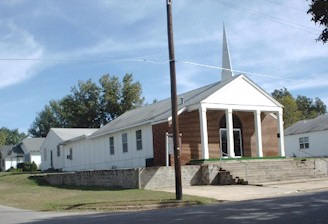|

David Flick
The Facade
The Southern Baptist Convention is like a Baptist church with a
facade. Looking straight at it from the front, one might see a nice
structure covered with brick. But taking a side view, one
will observe a decaying structure with a crumbling foundation.

The facade gives a false impression about the condition of the
building. Over the past quarter
century, the SBC leaders have constructed a facade that betrays the
crumbling condition of the denominational building. To the casual inside
observer, everything appears to be beautiful and proper. To the casual
outside observer, the decay is obvious.
The false front constructed
by current Southern Baptist leaders betrays the decaying condition of
convention on several levels. A part of the facade involves the
autonomy of local churches. Historically, Baptists believed the
local church was totally autonomous, having the sole authority to make
decisions independent of all other Baptist bodies.
While Southern Baptist
leaders claim that local churches are totally autonomous in every way,
they maintain tight control from the top. No longer are local churches
free to determine their course on key issues. For example local
churches are consistently excluded when they ordain women. Local
churches who ordain women to become deacons and pastors are excluded
from fellowship in local associations. With the advent of the
2000 Baptist Faith and Message, it
is no longer acceptable for women to be senior pastors of local
churches. Local church autonomy is out the window. In its place is
accountability to powerful, controlling denominational leaders.
The facade effectively conceals biblical
relationship between believers and their relationship with God. While
denying that confessions of faith carry mandatory authority, the 2000
BF&M states just the opposite. Layman, Bob Stephenson, wrote an
article that succinctly exposes the SBC building behind the facade.
The 1963 BF&M explicitly denied that our statements of faith are
“official creeds carrying mandatory authority.” This language is
deleted in the 2000 BF&M and replaced by the assertion that
statements of faith are
“instruments
of doctrinal accountability.”
This strikes at the very core of the
historic Baptist belief in “the priesthood of the believer.” Under
the 1963 BF&M, every Baptist is free to interpret scripture, under
the leadership of the Holy Spirit, without getting the approval of
any individual or group, including the pastor. Under the 2000 BF&M
we are
required
to be accountable “to each other” for holding approved
interpretations.
Is the Holy Spirit no longer
sufficient to guide you and hold you accountable? Who will be
calling on you whenever someone in your church thinks you need to be
held accountable for holding beliefs or expressing opinions that
differ from the 2000 BF&M? Who is going to assume the role of
official “accountability keeper” in your church?
Does such a thought seem preposterous
to you? Two years ago it seemed preposterous to professors in our
seminaries. A year ago it seemed preposterous to missionaries on
the mission field. A few months ago it seemed preposterous to lay
people in SBC churches in Oklahoma. Now accounts of such activity
are becoming commonplace.
Although the 2000 BF&M does not name
the pastor as the official “accountability keeper,” that is the
understanding that prevails among its revisers. They all share the
late W.A. Criswell’s conviction that, “The pastor is the ruler of
the church.”
The idea that the pastor should be a
“servant-shepherd,” rather than a “ruler,” is foreign to their
thought. (Bob
Stephenson, " A
Layman's Look at the 2000 Baptist Faith & Message)
Many churches lost local
autonomy in the matter of financial support for missions. Many
Southern Baptist churches have been punished for not exclusively supporting
the Cooperative Program. The current leaders strongly disdain the
mission efforts of the Cooperative Baptist Fellowship. Churches who
chose to render financial support to moderate Baptist missions
are severely punished by being excluded from fellowship in
associations when they resist the top-down mandates of
denominational leaders.
The Southern Baptist facade
gives the impression that women are equal to men in the family, the
church, and society. But the facade hides reality. Based on Article 18
in the 2000 BF&M, women are relegated to
subordinate status in all areas of life. (
A wife
submits
herself graciously to the servant leadership of her husband even as
the church willingly submits to the headship of Christ.)
This clause has created much division
throughout the SBC and has subjected Baptists to ridicule all across
the country. Such sexism is a stumbling block when witnessing to
women in Western Civilization.
Many
Baptist scholars have contended that the Bible teaches mutual
submission rather than male supremacism, but those in the SBC who
have said so publicly have been forced out of their places of service.
The facade of Article 18 declares
equality for women. Reality says women are to be "graciously
submitted" to their husbands in the home while holding a
second-rate status in the churches. The SBC leaders piously
attempt to explain themselves with a questionable interpretation of a
literal reading of Scripture. The SBC leaders attempt to
superimpose a 1st century cultural concept of women upon
21st women. The facade suggests that women are treated
equally in the denomination. Reality discloses that women are not
treated with equal dignity.
The facade erected by the
current generation of Southern Baptist leaders betrays the decaying of
Baptist traditions. The people in the pews have been duped by the
leadership. They do not see the decadence behind the facade. They are
uninformed. Many, if not most, really don't care. Why? Because they
are ignorant of true Baptist traditions.
- October 21, 2003
(This
article was written for BaptistLife.Com
Discussion Forums) |